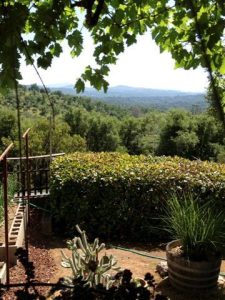It is wonderful to enjoy ripe, sweet fruit from trees that you have watered, pruned, and grown in your own yard. It is very difficult to find tasty, ripe fruit in the supermarket. When you grow your own, you will become famous with neighbors and family. It is several months since I picked fruit from my back yard orchard, froze the excess, and today I am still enjoying healthy, inexpensive fruit smoothies.
Already looking forward to your harvest? Maybe we should review the journey before we enjoy the finish line. There are demands trees put on our lives. Our success will be affected by our understanding these demands. Having an orchard requires desire, some time and stamina. Fruit tree care and harvest do not always balance with our daily schedule. A while ago my cherry tree was full of nice juicy red fruit and I announced to my family that tomorrow we would pick and enjoy the harvest. The following day about lunch time we embarked into our orchard with ladders and pails in hand. Oh – oh! The cherry tree was empty. The birds had feasted on all the fruit.
When planting a new orchard, it is a good idea to research types of fruit and their requirements before you purchase and plant. For best results, review your site and determine where best to plant each kind of tree before you begin. Site, water, soil, sun and protection are all basic considerations. Think about your orchard layout and density and put these thoughts in place for a good-looking, successful orchard.
Citrus requires a great deal of summer heat and a relatively frost free site. Planting next to my house has kept the citrus trees warm on cold days but frosty nights require additional protection with a covering of plastic or cloth. I like plastic because it magnifies the warmth and keeps the soil warm. Other trees, like many cherries, require another kind of cherry tree to provide blossom cross-pollination.
Fruit trees need sun. The first rays of sun before noon are important. I planted apricot trees in three different locations before receiving a harvest. First the soil was too wet, then the next area was too shady and finally the partial sun area was just right.
Soil needs good drainage to keep the roots from rotting. Sometimes a mound or a raised box can be a better choice. Most fruit trees prefer a soil pH close to 6. To reduce water needs, mulch around a tree out to the dripline, keeping it a foot or so away from the base of the tree.
Deer can damage the tree bark and chew branches as well as devouring the fruit. In our area, a 7 to 8 foot fence is usually required to protect from deer. A 6 foot fence may do the job, but if chased or threatened, deer can clear a greater height.
You can find more about deer protection plus how to protect your cherry crop from ravenous birds and other pests at www.ipm.ucdavis.edu/PDF/PESTNOTES/index.html. A wealth of other information can be found at homeorchard.ucanr.edu/The_Big_Picture/Irrigation/.
When you grow a home orchard you can grow the tastiest varieties most of which are not produced commercially. In your own orchard you have the freedom to select varieties that will give fruit many months of the year.
There is nothing like the satisfying experience of growing a home orchard that gives us a gift to share.
Jim Gormely, is a University of California Cooperative Extension Master Gardener of Tuolumne County.


